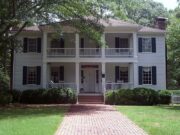The seat of Clayton County, Jonesboro is located in Georgia’s upper central Piedmont region, approximately eighteen miles south of Atlanta, just southeast of Hartsfield-Jackson Atlanta International Airport. It is the site of the 1864 Battle of Jonesboro and the fictionalized setting for Margaret Mitchell’s 1936 novel Gone With the Wind. (Mitchell’s grandmother was born and reared on a plantation nearby.) Jonesboro is also known as the home of 1984 Olympic swimming gold medalist Steve Lundquist.
History
Jonesboro lies in that part of Georgia first opened to white settlement by the 1821 Treaty of Indian Springs and long occupied by the Coweta tribe of the Creek Indian Confederation. The community was originally known as Leaksville and was at the crossroads of the old Strawn Trail, an Indian trail running from the southwest to Stone Mountain, and the White Hall Wagon Road, running from the present West End section of Atlanta south toward Griffin. The Strawn Trail became an early stagecoach route.
Construction of the Monroe Railroad to Leaksville in 1843 marked a new life for community. That same year the railroad’s chief engineer, Samuel Goode Jones, laid out a new town according to a formal plan that literally overlay the original village. In appreciation for Jones’s contribution, Leaksville was renamed Jonesboro. Regular service was opened on the railroad in 1846. The Macon and Western Railroad later became the Central of Georgia and is now a part of the Southern Railway system. Jonesboro immediately became an important railway trade center for a wide area in Fayette and Henry counties, although the town did not obtain its corporate charter until December 13, 1859.
As Jonesboro drew new citizens and merchants from the surrounding area, local leaders decided that it should become the seat of a new county. On November 30, 1858, an act of the state legislature created Clayton County, named for Augustin Smith Clayton, a distinguished attorney and congressman from Athens. The new county’s land was taken from the original 1821 counties of Fayette and Henry. Until 1858 Jonesboro lay in Fayette County on the Henry County line. As the seat of Clayton County, Jonesboro was a thriving small town until the Civil War (1861-65) brought an end to the old order. The town was virtually destroyed during the war due to Union raids and the Battle of Jonesboro. Recovery was slow, and as late as the 1890s ruins left from the war remained in the Main Street business district. Only a few antebellum buildings now survive.
Education and Industry
Clayton High School was established in Jonesboro in 1859 by Allen D. Candler, later governor of Georgia; it drew students from a wide area until it was closed during the Civil War. In 1880 Middle Georgia College was opened by George Cleveland Looney and continued until about 1895, when it moved farther south, to Cochran.
Jonesboro became a railroad commuter town for Atlanta in the 1890s. Local rail service offered several round-trip runs a day, and it became commonplace for people who lived in Jonesboro to work, shop, and attend amusements in Atlanta. This rail service ended during the 1920s as the automobile began its ascendancy over railroads. The Dixie Highway, connecting Chicago with Miami, was under construction through Jonesboro in 1924; it was one of the first paved highways traversing the state. The opening of U.S. Highway 19-41 (four lanes) in the mid-1950s and completion of Interstate 75 in 1969 quickly brought southward Atlanta’s urban sprawl, which ultimately engulfed Clayton County and entirely surrounded Jonesboro. Because new shopping centers have been constructed elsewhere in the county, much of the town’s old business district now houses professional offices and antique shops, although county government continues to occupy the historic courthouse (1898), newly renovated.
Now largely a bedroom community for Atlanta, Jonesboro has preserved its identity by translating its history into a tourist attraction. The 1867 railroad depot in the center of town is now the Road to Tara Museum and headquarters for the Clayton County Convention and Visitors Bureau. Nearby are the 1869 courthouse (Masonic Hall) and the 1869 jail, which is now a museum. The Johnson-Blalock House (originally built 1840, reconstructed 1859) on North Main Street and the Warren House (1860) on the north side of town are among the surviving antebellum structures. During the Battle of Jonesboro bodies of the dead and wounded were reputedly piled three deep in the grounds behind the Warren House. The Stately Oaks Plantation museum complex, built around an 1839 plantation house, offers insight into the area’s history through daily tours and a succession of special events including arts, crafts, living history demonstrations, and an annual reenactment of the Battle of Jonesboro.
Jonesboro’s population in 2000 was 3,829, and in 2002 the largest employers within the 2.6 square miles of its corporate limits were education and government. The Jonesboro-based Clayton County School System employed 6,800 people, and county government employed 2,000. Clayton State College and State University, a unit of the University System of Georgia, had 429 faculty and employees and more than 5,000 students in 2002. The Clayton County Convention and Visitors Bureau counted 16,535 visitors in 2001.




